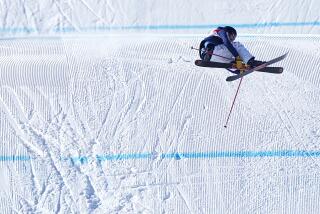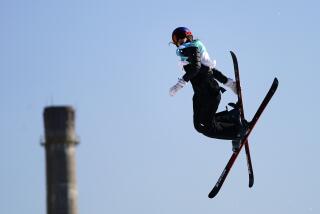Americans Swept Aside in Moguls
- Share via
SAUZE d'OULX, Italy — The Winter Games tried something different with freestyle skiing on Saturday, as evidenced by a fat, bright moon over the Italian Alps.
The 2006 Turin Games marked the first time in Olympic history that the final of the women’s moguls was held at night.
Some of the skiers remarked on how the dropping temperature cast an icy glaze over the snow. Others talked about the lighting, a faint shadow falling across the lower portion of the course.
But at least one thing was clear as day.
Jennifer Heil of Canada, a two-time overall World Cup champion, continued her dominance of the sport with a dramatic victory on the last run of the evening.
With a helicopter twirl on her first aerial, a back layout with an iron cross on her second, and some powerful technique amid the bumps, she edged out defending gold medalist Kari Traa of Norway and a surprising Sandra Laoura of France.
“I like all courses,” Heil said. “I like the powder, I like them firm.”
Her enthusiasm was not shared entirely by the four U.S. women who formed the competition’s deepest team but were -- for lack of a better term -- left out in the cold.
Only a few days earlier, one of the veterans of the team, defending silver medalist Shannon Bahrke, had talked about the vagaries of skiing freestyle moguls, saying: “Every course is known for a different thing.”
Her words could not have been more prophetic Saturday, when Sauze d’Oulx proved hard and fast down a hill of bumps punctuated by two jumps.
For the Americans, trouble started in the qualifying round as 19-year-old Hannah Kearney, the reigning world champion, landed on her heels after her first aerial.
“I was just kind of out of control,” she said. “I tried to pull it back but I couldn’t.”
Several bobbles left her on the bubble, bounced out of the competition on the second-to-last skier of the afternoon round.
“It’s not the end of the world,” the teenager said, shortly before breaking into tears and turning away from reporters.
Teammates Bahrke, Jillian Vogtli and Michelle Roark made it through but after darkness fell, none could muster a performance worthy of a medal.
“I definitely like a little more snow,” said Roark, who dropped from fourth in qualifying to 18th because of some rough going in the bumps. “Give me slush or something.”
While the Americans fell by the wayside, Heil and Traa moved toward a showdown.
Heil might have been the star of the moguls the last two seasons, but Traa has been an icon in the sport for years. Appearing in her fourth and final Olympics -- “My knees are a little bit sore and I need to do something else,” she said -- Traa recovered from a conservative, seventh-place run in qualifying by nailing an off-axis 720-degree move and a back layout in the final.
That put her in first place, where she remained through skier after skier, until Heil stood atop the hill for the last run.
At the 2002 Salt Lake City Games, the Canadian had finished fourth, missing a medal by a fraction of a point. Four years later, after some time off to recuperate from nagging injuries, she wasn’t about to play it safe.
If anything, the hard surface might have been a blessing. To perform well, she said, “I have to try to ski fast and ski more aggressively.”
So the Olympic nighttime experiment -- it had been tried in previous international events and will be repeated in other freestyle finals here -- suited her just fine.
The temperature had dropped another degree or two. The moon had risen directly over the starting gate.
It was, she said, “time to go out and let it happen.”
More to Read
Go beyond the scoreboard
Get the latest on L.A.'s teams in the daily Sports Report newsletter.
You may occasionally receive promotional content from the Los Angeles Times.







